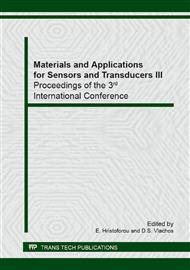p.432
p.437
p.441
p.445
p.449
p.453
p.457
p.461
p.465
Influence of Filler Geometry on Melt Strength of Poly(lactid acid) Composites with Different Electrically Conductive Fillers
Abstract:
Polymer materials manufactured of natural resources have been characterized. Polylactid acid (PLA) was used as a matrix for composites filled with carbonaceous fillers of different geometry (carbon black and carbon nanofibres). Polymer strands made of electrically conductive PLA composites have a promising potential as materials for fabrication of sensors sensitive to strain, temperature or organic solvents. For better understanding of the correlation between processing parameters of PLA composites and their sensing ability the melt characteristics have been evaluated using a capillary rheometer and Rheotens melt strength tester. Strain sensing was monitored under three point bending by means of electrical conductivity measurements.
Info:
Periodical:
Pages:
449-452
Citation:
Online since:
April 2014
Authors:
Price:
Сopyright:
© 2014 Trans Tech Publications Ltd. All Rights Reserved
Share:
Citation:


